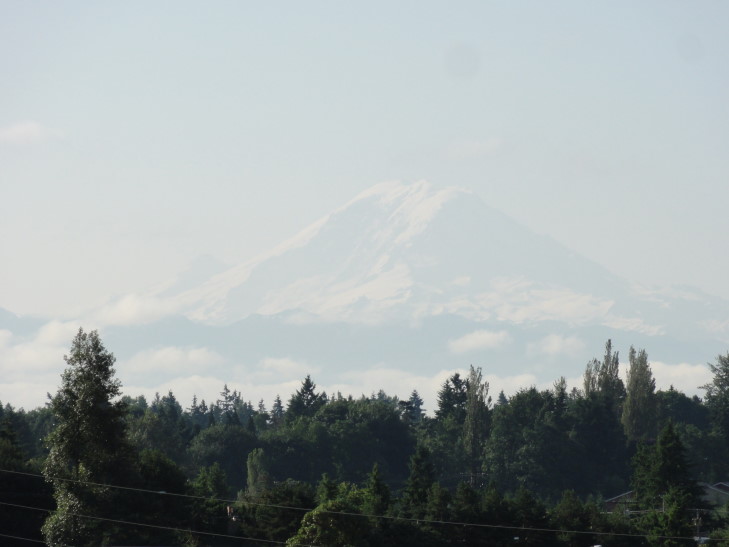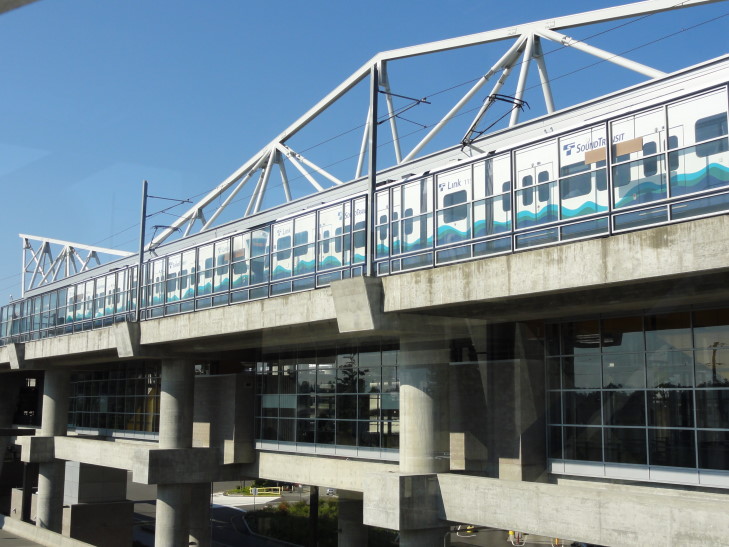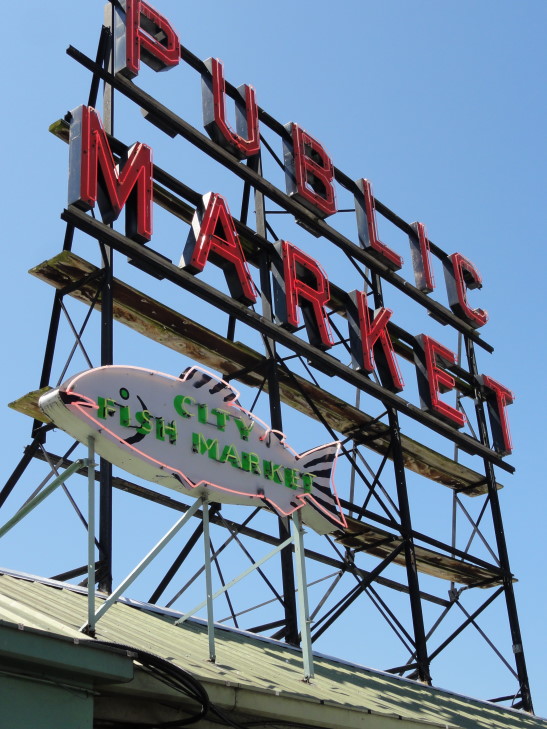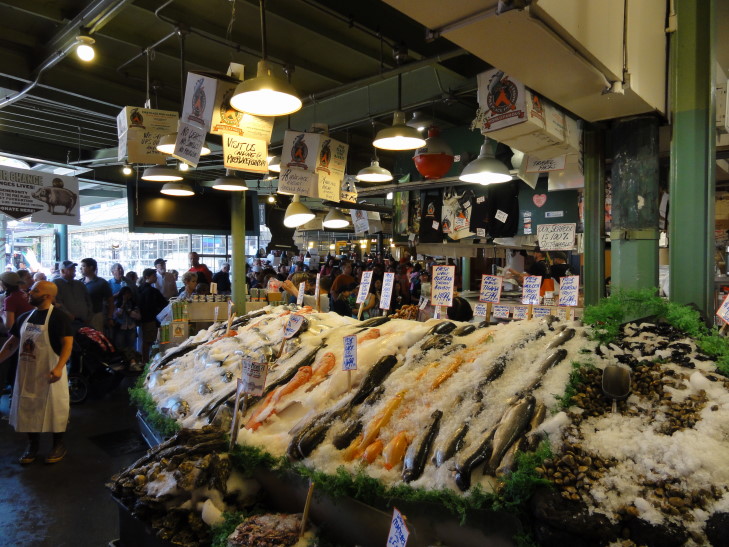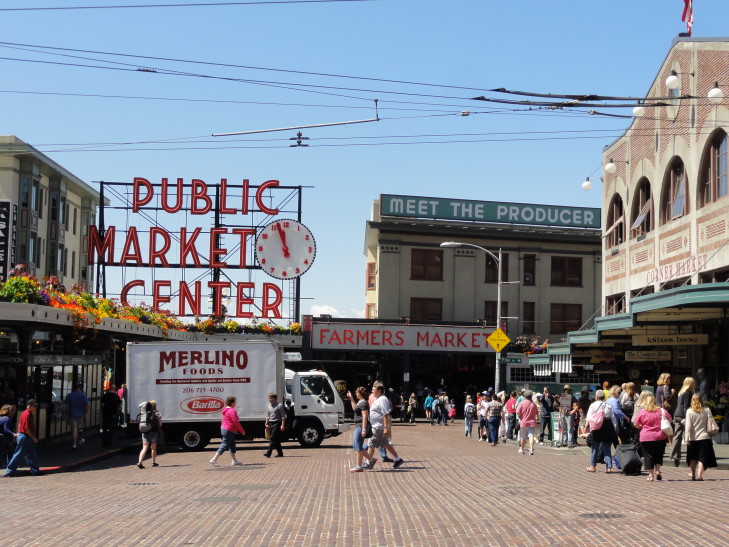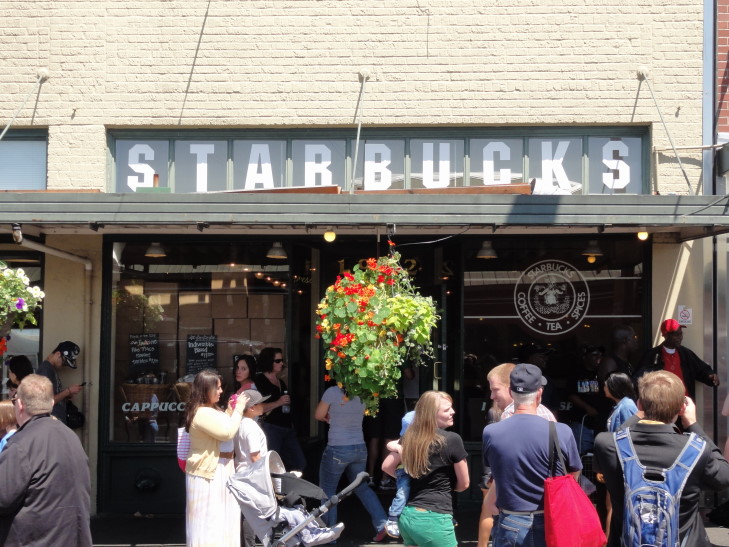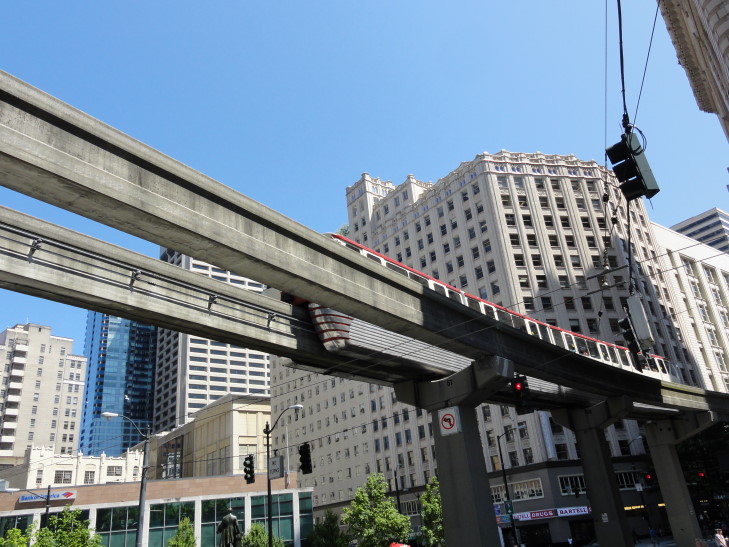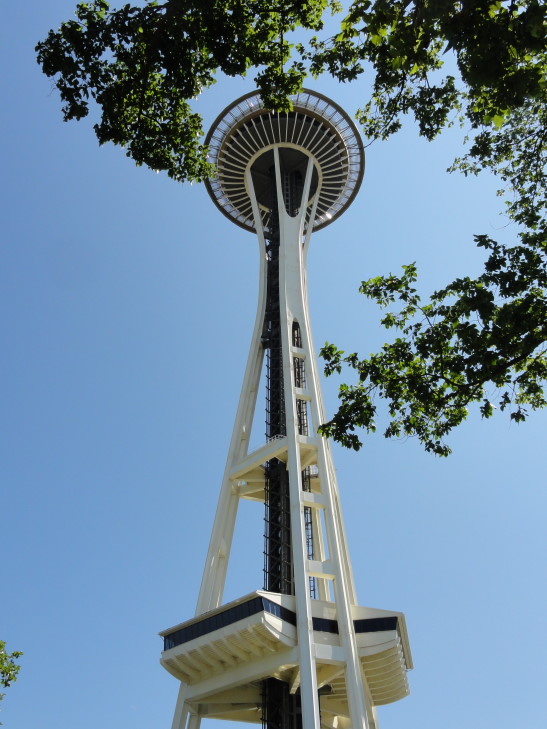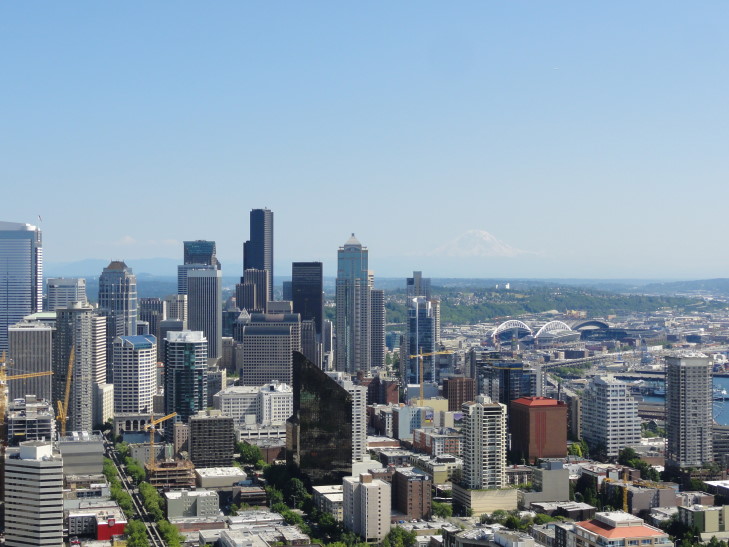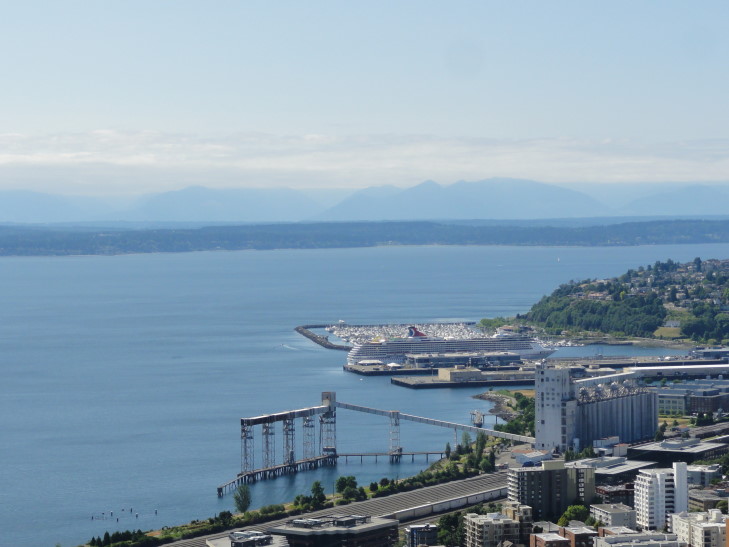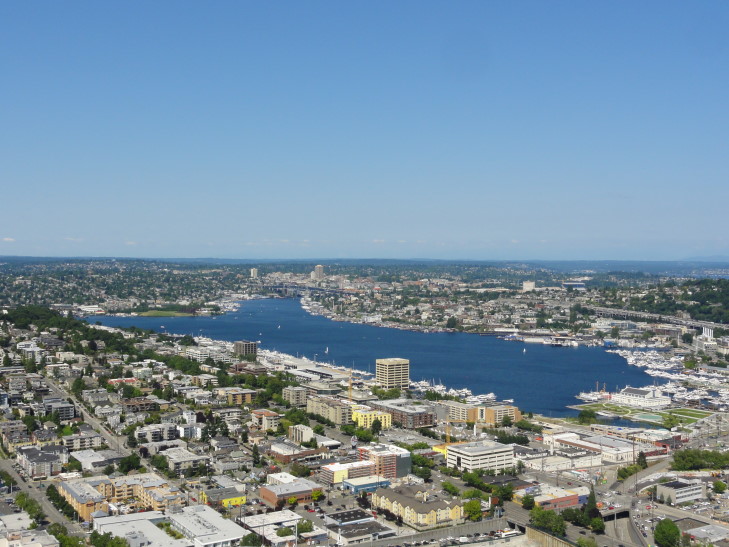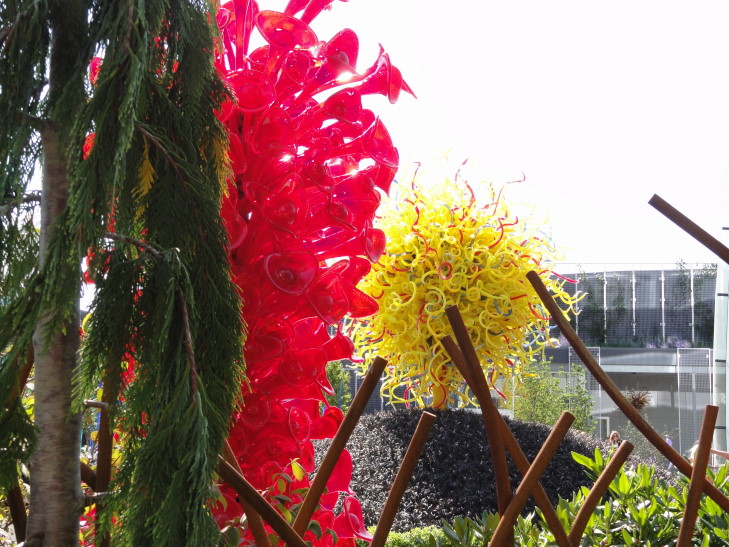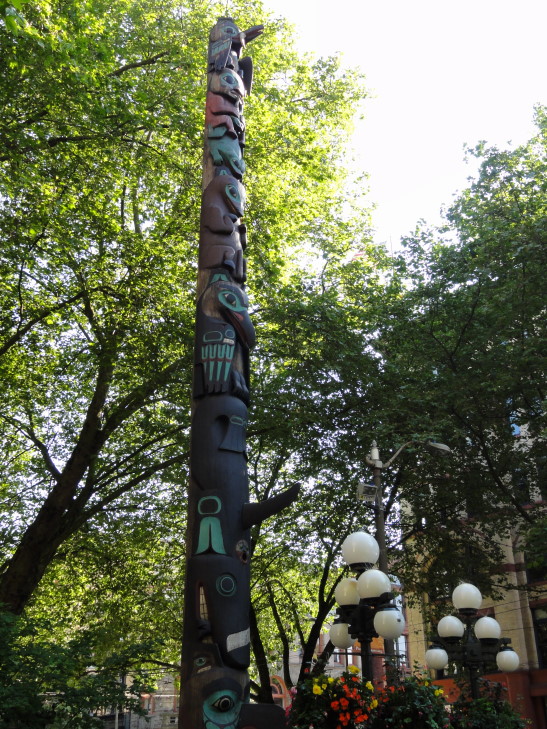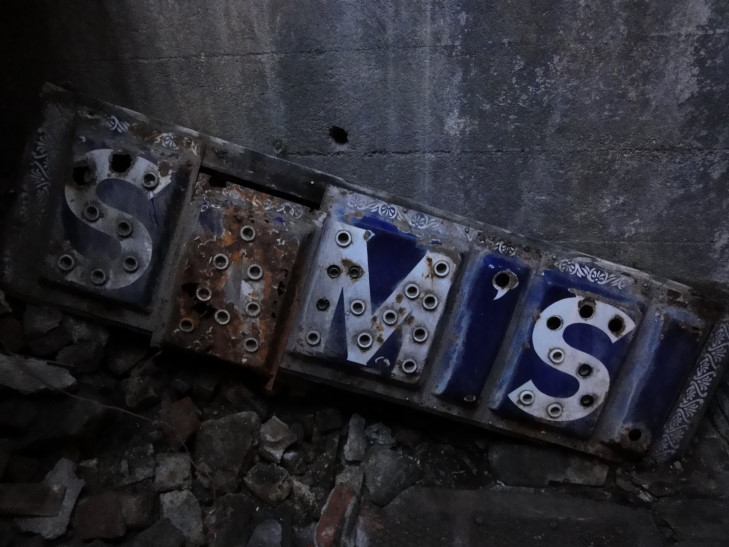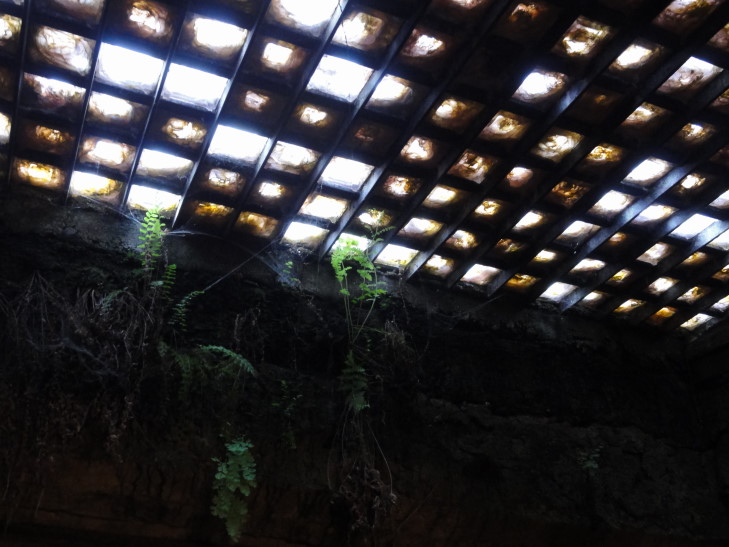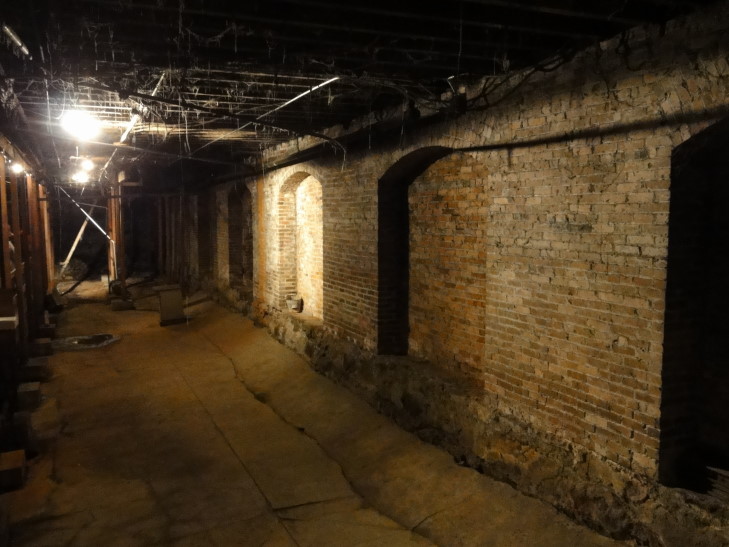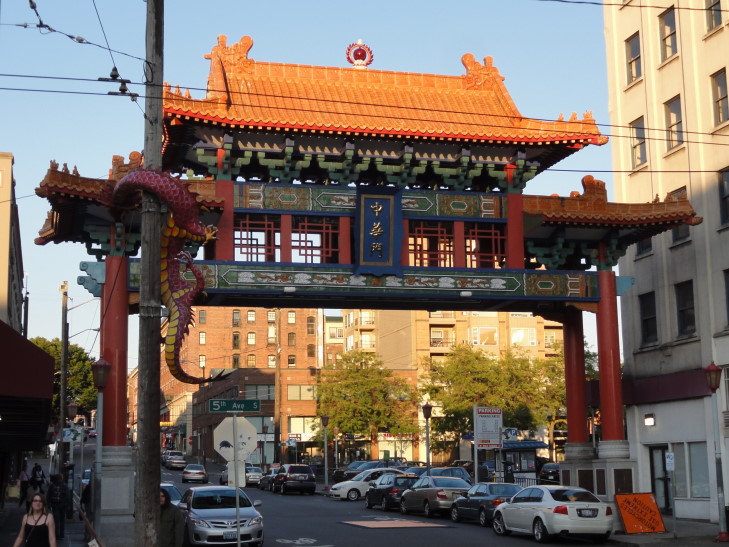Woke up early for our day in Seattle and got greeted by an amazing sight out of our window: Mount Rainier. It was “out” today (as opposed to when it is clouded in) and just spectacular, floating above the horizon in an almost otherworldly way. Easily one of the most mesmerizing things I’ve ever seen. Looks like we caught a major break with Seattle having a sunny day — the week before was all rain and clouds.
The picture doesn’t come close to doing it justice. Mount Rainier is a 14,411 foot mountain about fifty miles from Seattle. It has twenty six glaciers on its slopes and is considered to be one of the ten most dangerous volcanoes in the world due to the tremendous impact it would have on the surrounding communities should it erupt and the glaciers help create a tremendous lahar down the nearby Puyallup River valley.
After a buffet breakfast at the hotel we learned that we could get into Seattle by taking their light rail system, the southernmost stop of which happened to be across the street and accessible by a sky way. What luck, as we had not really wanted to drive around Seattle. The train was quite fast, keeping pace with cars on the adjacent (in parts) interstate. We also got to see a number of interesting communities along the way with many murals adorning buildings and such. We passed Safeco Field (used by the MLB Mariners) and the Seahawks’ (of the NFL) stadium. Closer to downtown the light rail when into a tunnel that it shared with the cities many buses. I had never seen that, quite ingenuous!
We rode the light rail all the way to the end, emerging below a mall area called Westlake Center or some such. After a short walk down a mild hill, then up again, then down a steep hill we came upon the Pike Street Public Market. The Public Market is an interesting place. Part farmer and fisherman market, part mall with small shops, and home to some seafood restaurants (Lowell’s, Athenian) with incredible views of Puget Sound.
The market is also known for its fish vendors tossing fish around. We saw a few doing it, but it certainly wasn’t ubiquitous. Maybe had something to do with it being late morning on a Tuesday, but I was a little disappointed.
Lower down in the market was a store that sold many comics, RPGs, and collectibles. Mostly recent stuff that can be found anywhere but they also had a display case with old Star Wars figures which was impressive — I remembered a few of the toys. They also had a cute magnet of a stick person with arms raised in what appeared to be water in the form of squiggly lines. The caption was “Yay! Bacon!” (the squiggles did look like bacon, after all!) Michelle talked me out of it, though. Also got a glimpse of some unopened Magic: The Gathering boosters they had. Their Dark booster was $20, Antiquities $100, and Unlimited $500! Fallen Empires was $3.95 though, haha.
Spying a Starbucks and thinking it was the site of the first one, and Genetta craving a bit of coffee, we learned that the original Starbucks was further down the street a block or two away, right across from the market.
We returned to the market and ate at the Athenian restaurant. A scene from Sleepless in Seattle was filmed there and I amused myself greatly explaining to the kids that Meg Ryan must’ve divorced Billy Crystal after their fling and Tom Hanks had dumped mermaid Daryl Hannah. They didn’t understand a word of it. Man, I’m feeling old. The food itself was excellent — I had the reuben, Michelle some prawns and chips, Genetta a huge bowl of tomato bisque, and Addison a very large bacon double cheeseburger. Even better was that every table was a window view on to beautiful Puget Sound and the dock area (including a Ferris wheel).
We continued on through the market, tempted by things but standing firm (as anything we buy we have to figure out how to cart around). Along the way we caught a glimpse of the first Starbucks across the street from the market. It was preserved as it appeared upon opening in 1971 as it is part of a preserved historic district. As it was packed we decided that seeing it was enough.
Nearby stood a small park with a large totem pole in it. Despite being small it was packed with people enjoying the sun and the amazing views of the Sound. We walked back up the very steep hill and back to the shopping center that housed the light rail station. This time, however, we hopped on board a monorail via a station in the food court on the top floor. The monorail took us to Seattle Center, a 74 acre area containing museums, parks, and the Space Needle that was created for the 1962 World’s Fair. The monorail and Space Needle were both created for the fair, and both celebrating 50 years. Elvis had even ridden the monorail!
The Space Needle was only a very short distance away. We purchased tickets and stood in a very long line. The line moved fast and, other than a person behind us that kept disrespecting Michelle’s personal space, the wait was uneventful. Along the line’s route there were signs giving out facts about the Space Needle, including that Supernatural’s own Jensen Ackles likely visited during filming of “Dark Angel”, something that made Michelle happy!
The line over, we were assigned to one of the Space Needle’s three glass elevators that would take us up to the observation deck (both indoor and out) at 520′. The guide informed us that when it was built in 1962 the Space Needle was the tallest building west of the Mississippi. Now it is only the seventh tallest building in Seattle. As he quipped, “Progress.”
The view from the top was magnificent. Not only of downtown and Mount Rainer to the south but (going clockwise) also Puget Sound with the Olympic Mountains behind it, the northern suburbs of Seattle including Lake Union, and further east a glimpse of Lake Washington and the Cascades beyond. We also occasionally saw seaplanes angling in and landing on the surface of Lake Union. Very cool.
After a brief stop in the gift shop where Michelle found a really cool magnet celebrating the Space Needle’s 50th anniversary we headed on. We elected not to see the rest of the sights in Seattle Center which includes EMP (the Experience Music Project), a cool glass sculpture museum and garden (Chihuly Garden and Glass, thanks mom for pointing that out), and the Pacific Science Center (which was hosting the traveling exhibition of King Tut’s artifacts — though Michelle and I had already seen them in 1994 on our honeymoon in Cairo).
We had decided to pass on them so that we could make it down to Pioneer Square and the Seattle Underground tour. Jumping back onto the monorail and then the light rail we made it to Pioneer Square (the oldest part of Seattle) with time to spare for the 5 o’clock tour. We had feared that it would be the last tour of the day but it turns out that in the summer they added more so we were in no danger of missing.
After a brief rest highlighted by some light refreshments of Coke and Raisenettes we attended the introduction to the tour which gave an entertaining overview of the early history of Seattle. The town was founded in 1852 by a family from Illinois, encouraged to settle by the United States offering them free land (820 acres per person) in a (successful) attempt to prevent the British from claiming that as far south as the Columbia River (between Washington and Oregon) was part of Canada. They thought that they had found a perfect place of over one thousand acres but it turned out that the tide was out. Once the tide fully came back in it shrank to eight acres! As there were only a handful of settlers they made do.
It was originally known as Duwamps and the primary industry was felling the incredible stands of timber that stood all about the area. In fact, the logs were felled and skidded down a road to the waiting lumber mill — the origins of the term “skid row.” Doc Maynard, also one of the city founders, arrived in 1852 as well and, having planned Cleveland, Ohio, was instrumental in helping to plan Seattle. He also realized that “Duwamps” would never be a catching name and used the name of a friend, Chief Seattle, as the new name of the town. Doc Maynard had intended to head to California but instead ended up in Seattle as he fell in love with a woman he treated for cholera (he was sadly — and perhaps conveniently — unable to save her husband) who decided to go north to her brother’s in Olympia rather than to California.
Sadly for the town, however, it seems that nobody was great at sanitation issues. Originally there were just privies on the high ground that would spill their contents downhill and to the tidal flats. With the invention of the toilet (by, funnily enough, Thomas A. Crapper) sewer pipes were introduced to Seattle — though they were just six inch hollowed logs that were not buried but rather elevated and at a very steep angle to discharge into Puget Sound. The tide would carry the waste down to rival city Tacoma, but the return tide would just bring it back — “Tacoma’s Revenge.” The returning tide would also put pressure on the outflow end of the sewer system, leading to waste geysers sprouting from people’s toilets at certain times of day. ICK!
The town burned to the ground in 1889 when a cabinet maker’s apprentice attempted to soften a glue block and left the flame unattended a bit. Luckily nobody died and this afforded the perfect opportunity to solve Seattle’s terrible sanitation issue.
We went out on the street and then down some steps into cool passages below the modern sidewalks. What the city did was build retaining walls (from just 8′ high to almost 30′ high, as they wanted to change the slope of the town from 46 percent to 18) on either side of the old streets and filled them with dirt in between, burying the sewer pipes underneath the new streets.
This left the sidewalks and buildings (as they had rebuilt before the street raising was done, as they needed to get back to business) many feet below the street, however. The town installed ladders at every intersection so that the townsfolk could climb up a ladder, cross the street, and then climb back down. Our guide joked that this was a one step program for quitting drinking as 17 people died while drunk, some falling from as high as thirty feet to their deaths. Eventually, new sidewalks were built at street level, supported by I-beams between the building walls and the granite retaining walls spanned by brick arches. The lower sidewalks were still in use, however, and most buildings had a street-level and a below street-level entrance.
To solve the issue of light skylights were installed in the upper sidewalks. The glass was infused with manganese to prevent it from turning brown but instead sunlight would normally cause the glass to turn purple-ish in ten years. Due to Seattle’s famous rain, however, it took 35 years!
It was neat down there. We saw the foundations of some buildings including a bank and a dry goods store. We learned that Seattle made a ton of money “mining the miners” during the Alaska Gold Rush of the 1890s. Word that gold was found reached Seattle and many, including the current mayor, ran off to seek their fortunes. Canada passed a law requiring that each miner have a ton of supplies before passing through, however, so those that stayed behind in Seattle became rich selling supplies. Prior to the Alaska Gold Rush all of the businesses in Seattle combined made $300,000 a year. During the gold rush that grew to $25M a year! All the gold going through was stored in the aforementioned bank, which was robbed and a teller killed — some say his ghost roams the Underground still!
We also learned that much of early Seattle’s tax revenue came from taxing prostitution, though the tour guide used a euphemism of calling them “seamstresses” since that was often the occupation they claimed. Eventually the Underground fell into disuse until a gentleman started tours in the 1960s and helped preserve the entire neighborhood as one of the nation’s first historic districts.
After the tour was over we headed back to the light rail and got off on the next stop, Chinatown. There we were greeted by an incredible gate and there were sculptures of dragons on the lamp posts. We ate at a nearby restaurant called The Red Lantern that was good — Michelle had crab rangoons, Genetta had chicken fried rice, and I had Mongolian beef while Addison just ate from each. After dinner I had a yummy desert of vanilla ice cream on top of sponge cake and drizzled with strawberry coulis and blueberries. Yum!
Full, we headed back to the hotel via the light rail arriving right at dusk (about 9 o’clock). Sadly I missed some great sunset shots of Mount Rainier. Hopefully I’ll get some good ones tomorrow when we go to Mount Rainier National Park.
